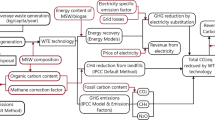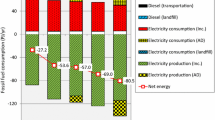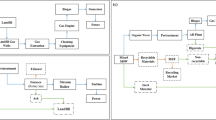Abstract
This study estimated the amounts of municipal solid waste, greenhouse gas emissions and mitigation potential, and energy production potential from waste management in Thailand from 2017–2050. According to a grey forecasting model (GM 1,3), waste generation is predicted to increase at an average rate of 1.15% year–1 and will reach 39.61 M tons in 2050. Four waste management scenarios were investigated including: a baseline scenario, in which waste management practices in 2017 remain unchanged; scenario 1, which includes installation of waste-to-energy incineration plants from 2018–2021; scenario 2, which assumes the waste-to-energy target (900 MWe) is accomplished; and scenario 3 which maximizes waste sorting and material recovery. In the baseline scenario, greenhouse gas emissions will reach 18,972 kt CO2eq and the power production potential will be 179 MWe in 2050. Scenario 2 provides maximum waste disposal reduction, resulting in the greatest greenhouse gas mitigation. Its greenhouse gas emissions are 20% lower than the baseline in 2030, and 47% in 2050. The power production potential in scenario 2 in 2050 (910 MWe) can help prevent 11,756 kt CO2eq of greenhouse gas emissions from fossil fuel consumption. Scenario 1 provides the smallest greenhouse gas mitigation potential, with only 7% reduction in 2030 compared to the baseline. However, all scenarios can help Thailand meet its Nationally Determined Contributions targets. Findings from this study provide some insights for policy makers and researchers in evaluating waste management and climate policies.








Similar content being viewed by others
References
Abdallah M, Shanableh A, Arab M, Shabib A, Adghim M, El-Sherbiny R (2019) Waste to energy potential in middle income countries of MENA region based on multi-scenario analysis for Kafr El-Sheikh Governorate Egypt. J Environ Manage 232:58–65. https://doi.org/10.1016/j.jenvman.2018.11.029
ASTM International (2016) Standard test method for determination of the composition of unprocessed municipal solid waste. In: (Vol. D5231–92), West Conshohocken
CAIT (2020) Climate watch historical GHG emissions. World Resources Institute, Washington, DC. https://www.climatewatchdata.org/ghg-emissions. Accessed 28 Apr 2022
Chaves GLD, Siman RR, Ribeiro GM, Chang NB (2022) The potential of refuse-derived fuel production in reducing the environmental footprint of the cement industry. In: Muthu SS (ed) Environmental footprints of recycled products. Springer, Singapore (eBook).
Chommontha N, Phongphiphat A, Wangyao K, Patumsawad S, Towprayoon S (2021) Effects of operating parameters on co-gasification of coconut petioles and refuse-derived fuel. Waste Manage Res. https://doi.org/10.1177/0734242X211003974
Chung Y, Paik C, Kim YJ (2018) Assessment of mitigation pathways of GHG emissions from the Korean waste sector through 2050. Sustain Environ Res 28(3):135–141. https://doi.org/10.1016/j.serj.2017.12.003
DEDE (2020) Alternative energy development plan: AEDP 2018. In: Department of Alternative Energy Development and Energy Conservation (DEDE), Bangkok
Deng J (1982) Control problems of grey systems. Syst Control Lett 1(5):288–294. https://doi.org/10.1016/S0167-6911(82)80025-X
Ding S, Xu N, Ye J, Zhou W, Zhang X (2020) Estimating Chinese energy-related CO2 emissions by employing a novel discrete grey prediction model. J Clean Prod 259:120793. https://doi.org/10.1016/j.jclepro.2020.120793
DOPA (2021) Official statistics registration systems. Department of Provincial Administration (DOPA). https://stat.bora.dopa.go.th/stat/statnew/statMONTH/statmonth/#/view. Accessed 15 Jun 2021
EEA (2021) Annual European union greenhouse gas inventory 1990–2019 and inventory report 2021-Submission to the UNFCCC Secretariat (EEA/PUBL/2021/066). https://www.eea.europa.eu/publications/annual-european-union-greenhouse-gas-inventory-2021. Accessed 20 Dec 2021
ERC (2021) Summary of information of electric power plant. Energy Regulatory Commission (ERC) of Thailand. http://www.erc.or.th/ERCSPP/Default.aspx. Accessed 29 Oct 2021
FAO (2020) FAOSTAT emissions database. https://www.fao.org/faostat/en/#data/GT. Access 28 Apr 2022
Hajar HAA, Tweissi A, Hajar YAA, Al-Weshah R, Shatanawi KM, Imam R, Hajer MAA (2020) Assessment of the municipal solid waste management sector development in Jordan towards green growth by sustainability window analysis. J Clean Prod 258:120539. https://doi.org/10.1016/j.jclepro.2020.120539
Hyndman RJ, Athanasopoulos G (2018) forecasting: principles and practice. https://otexts.com/fpp2/. Accessed 4 Mar 2021
Intharathirat R, Abdul Salam P, Kumar S, Untong A (2015) Forecasting of municipal solid waste quantity in a developing country using multivariate grey models. Waste Manage 39:3–14. https://doi.org/10.1016/j.wasman.2015.01.026
IPCC (2006) IPCC guideline for national greenhouse gas inventories volume 5: Waste
IPCC (2014) Climate change 2014: synthesis report. In: Pachauri RK, Meyer LA (eds) Contribution of working groups I, II and III to the fifth assessment report of the intergovernmental panel on climate change, Geneva
IUCN-EA-QUANTIS (2020) National Guidance for plastic pollution hotspotting and shaping action. https://www.iucn.org/sites/dev/files/contentdocuments/thailand_finalreport_2020_compressed.pdf. Accessed 12 Mar 2021
Kiran M, Shanmugam PV, Mishra A, Mehendale A, Nadheera Sherin HR (2021) A multivariate discrete grey model for estimating the waste from mobile phones, televisions, and personal computers in India. J Clean Prod 293:126185. https://doi.org/10.1016/j.jclepro.2021.126185
Kumar A, Sharma G, Naushad M, Al Othman ZA, Dhiman P (2022) Environmental pollution remediation via photocatalytic degradation of sulfamethoxazole from waste water using sustainable Ag2S/Bi2S3/g-C3N4 Nano-Hybrids. Earth Syst Environ 6:141–156. https://doi.org/10.1007/s41748-021-00223-8
Lewis CD (1982) Industrial and business forecasting methods. Butterworth Scientific, London
Liu S, Yang Y, Forrest J (2017) Grey data analysis (vol. 10). Springer. https://doi.org/10.1007/978-981-10-1841-1
Manomaivibool P, Srivichai M, Unroj P, Dokmaingam P (2018) Chiang rai zero waste: participatory action research to promote source separation in rural areas. Resour Conserv Recycl 136:142–152. https://doi.org/10.1016/j.resconrec.2018.04.002
McQuibban J (2020) Achieving the EU's waste targets: zero waste cities showcasing how to go above and beyond what is required. In: Recupero R (ed) Zero Waste Europe
NESDB (2013) Population projections for Thailand 2010–2040. In: Office of The National Economic and Social Development Board (NESDB), Bangkok
NESDC (2021) Gross domestic product, chain volume measures. In: Office of The National Economic and Social Development Council (NESDC). https://www.nesdc.go.th/nesdb_en/more_news.php?cid=155. Accessed 11 Nov 2021
OECD/IEA (2020) CO2 Emissions from Fuel Combustion. https://iea.blob.core.windows.net/assets/474cf91a-636b-4fde-b416-56064e0c7042/WorldCO2_Documentation.pdf Access 28 Apr 2022
ONEP (2015) Thailand Climate Change Master Plan 2015 - 2050. Office of Natural Resources and Environmental Policy and Planning (ONEP), Bangkok
ONEP (2017) Thailand's nationally determined contribution (NDC) roadmap on mitigation. In: Office of Natural Resources and Environmental Policy and Planning (ONEP), Bangkok
ONEP (2020) Thailand's updated nationally determined contribution. In: Office of Natural Resources and Environmental Policy and Planning (ONEP). https://www4.unfccc.int/sites/ndcstaging/PublishedDocuments/Thailand%20First/Thailand%20Updated%20NDC.pdf Accessed 6 Dec 2021
PCD (2016) National Waste Management Master Plan (2016–2021). Pollution Control Department (PCD), Bangkok
PCD (2017a) Reduce reuse recycle: 3R (Draft). Pollution Control Department (PCD), Bangkok
PCD (2017b) The situation report of municipal solid waste of Thailand in year 2016. Pollution Control Department (PCD), Bangkok
PCD (2018) The situation report of waste disposal sites of Thailand in year 2017. Pollution Control Department (PCD), Bangkok
PCD (2021) Information system on municipal solid waste management. Pollution Control Department (PCD). https://thaimsw.pcd.go.th/report1.php?year=2563 Accessed 23 Nov 2021
Peng Y, Lu S, Li X, Yan J, Cen K (2020) Formation, measurement, and control of dioxins from the incineration of municipal solid wastes: recent advances and perspectives. Energy Fuels 34:13247–13267. https://doi.org/10.1021/acs.energyfuels.0c02446
Periyasamy AP, Militky J (2020) LCA (life cycle assessment) on recycled polyester. In: Muthu SS (ed) Environmental footprints of recycled polyester. Springer Singapore (eBook).
Phongphiphat A, Cheewaphongphan P, Towprayoo S (2015) Forecasting MSW generation and energy potential from all municipalities in Thailand to 2030. In: Paper presented at the International Waste Working Group Asian Regional Branch (IWWG-ARB), Shanghai, China
Phongphiphat A, Limpiti T, Pudcha T (2019) Thailand's MSW forecasting model for sustainable MSW management and utilization. In: Center of excellence on hazardous substance management
Pudcha T (2019) Development of MSW scenario forecasting based on grey model for zero waste management in Thailand. King Mongkut’s University of Technology Thonburi, Bangkok
Pudcha T, Phongphiphat A, Towprayoon S (2019) Forecasting Energy potential from municipal solid waste (MSW) in Thailand by using grey model. In: Proceeding of 4th Symposium of International Waste Working Group Asian Regional Branch (IWWG-ARB), 20–22 February 2019, Bangkok, Thailand. pp. 87–92.
Rosen MA (2021) Energy Sustainability with a Focus on Environmental Perspectives. Earth Syst Environ 5:217–230. https://doi.org/10.1007/s41748-021-00217-6
Saunois M, Stavert AR, Poulter B, Bousquet P, Canadell JG et al (2020) The global methane budget 2000–2017. Earth Syst Sci Data 12:1561–1623. https://doi.org/10.5194/essd-12-1561-2020
Saxena A (2021) Grey forecasting models based on internal optimization for Novel Corona virus (COVID-19). Appl Soft Comput 111:107735. https://doi.org/10.1016/j.asoc.2021.107735
Skea J, Shukla PR, Reisinger A, Slade R, Pathak M, et al. (2022) Summary for Policymakers. In IPCC (2022) Climate Change 2022: Mitigation of Climate Change. Contribution of Working Group III to the Sixth Assessment Report of the Intergovernmental Panel on Climate Change [Shukla PR, Skea J, Slade R, Al Khourdajie A, van Diemen R, et al. (eds.)]. Cambridge University Press, Cambridge, UK and New York, NY, USA.
TGO (2016) Grid emission factor in year 2016 (B.E. 2559). Thailand Greenhouse Gas Management Organization (TGO, Public Organization), Accessed 18 Feb 2018 from, http://ghgreduction.tgo.or.th/images/Grid_Emission_Factor_2559_-_Finalised.pdf
Towprayoon S, Phongphiphat A (2013) Greenhouse gas reduction from solid waste management at municipality level of Thailand. Thailand Greenhouse Gas Management Organization (TGO, Public Organization)
Udomsri S, Petrov MP, Martin AR, Fransson TH (2011) Clean energy conversion from municipal solid waste and climate change mitigation in Thailand: waste management and thermodynamic evaluation. Energy Sustain Dev 15(4):355–364. https://doi.org/10.1016/j.esd.2011.07.007
UNEP (2021) Emissions gap report 2021: The heat is on—a world of climate promises not yet delivered. Nairobi. United Nations Environment Programme (UNEP), Accessed 20 Dec 2021 from https://www.unep.org/resources/emissions-gap-report-2021
UNFCCC (2021) Mid-century, long-term low greenhouse gas emission development strategy: Thailand. Accessed 28 Apr 2022 from https://unfccc.int/sites/default/files/resource/Thailand_LTS1.pdf
Yaman C, Anil I, Alagha O (2020) Potential for greenhouse gas reduction and energy recovery from MSW through different waste management technologies. J Clean Prod. https://doi.org/10.1016/j.jclepro.2020.121432
Zhang Z, Zhang Y, Wu D (2019) Hybrid model for the prediction of municipal solid waste generation in Hangzhou. China Waste Manag Res 37(8):781–792. https://doi.org/10.1177/0734242X19855434
Acknowledgements
The authors would like to thank Asst. Prof. Dr. Komsilp Wangyao, Asst. Prof. Dr. Chalor Jarusutthirak, Dr. Rotchana Intharathirat, Dr. Akarapong Untong, and Mr. Supajit Sukkanta for their guidance, and the Center of Excellence on Hazardous Substance Management, Chulalongkorn University, for financial support during database development. The authors would like to express their gratitude to The Joint Graduate School of Energy and Environment, King Mongkut's University of Technology Thonburi and the Center of Excellence on Energy Technology and Environment, Ministry of Higher Education, Science, Research and Innovation for the financial support to perform this study.
Funding
Financial support for this research was provided by The Joint Graduate School of Energy and Environment, King Mongkut's University of Technology Thonburi, The Center of Excellence on Energy Technology and Environment, and The Center of Hazardous Substance Management, PERDO, Ministry of Higher Education, Science, Research, and Innovation.
Author information
Authors and Affiliations
Contributions
All authors contributed to the study conception and design. Material preparation, data collection and analysis were performed by TP and AP. The first draft of the manuscript was prepared by TP. AP and ST revised the manuscripts. All authors commented on the manuscript improvements, and read, and approved the final manuscript.
Corresponding author
Ethics declarations
Conflict of Interest
On behalf of all authors, the corresponding author states that there is no conflict of interest.
Supplementary Information
Below is the link to the electronic supplementary material.
Rights and permissions
About this article
Cite this article
Pudcha, T., Phongphiphat, A. & Towprayoon, S. Greenhouse Gas Mitigation and Energy Production Potentials from Municipal Solid Waste Management in Thailand Through 2050. Earth Syst Environ 7, 83–97 (2023). https://doi.org/10.1007/s41748-022-00323-z
Received:
Revised:
Accepted:
Published:
Issue Date:
DOI: https://doi.org/10.1007/s41748-022-00323-z




